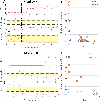Quantification of movement in normal and parkinsonian macaques using video analysis
- PMID: 31055027
- PMCID: PMC6726117
- DOI: 10.1016/j.jneumeth.2019.05.001
Quantification of movement in normal and parkinsonian macaques using video analysis
Abstract
Background: Quantification of spontaneous animal movement can be achieved using analysis of video recordings of the animals. Previous reports of video-based methods are based on outdated computer platforms or require the use of specialized equipment.
New method: We developed a video analysis algorithm to quantify movement based on the commonly used MATLAB programming language. The algorithm is based on pixel differences between frames of video footage acquired with a standard video camera.
Results: The new algorithm was validated, analyzing the amount of movements made by monkeys undergoing treatment with the dopaminergic neurotoxin 1-methyl-4-phenyl-1,2,3,6-tetrahydropyridine (MPTP) to induce parkinsonism. We compared the movement quantification generated by the new system of analysis with results obtained with a conventional infrared beam break counting system, a parkinsonism rating scale, and accelerometry-based motion quantification in three rhesus macaques. The information provided by our video analysis method was consistent with that obtained with the first two methods, and more detailed than the third.
Comparison with existing methods: The new method can replace other methods to quantify movement. Although other video analysis methods have been described, some have since been deprecated, or involve the use of specialized hardware. The new method provides a straightforward and fast approach of analyzing the amount of movement in caged experimental animals, using conventional off-the-shelf equipment and moderate computing resources.
Conclusions: This video analysis method provides an affordable, open access platform to quantify animal movement.
Keywords: Movement quantification; Nonhuman primates; Parkinsonism; Video-based movement analysis.
Copyright © 2019 Elsevier B.V. All rights reserved.
Figures




References
-
- Campos-Romo A, Ojeda-Flores R, Moreno-Briseno P, Fernandez-Ruiz J. Quantitative evaluation of MPTP-treated nonhuman parkinsonian primates in the HALLWAY task. J Neurosci Methods, 2009; 177: 361–8. - PubMed
-
- Chassain C, Eschalier A, Durif F. Assessment of motor behavior using a video system and a clinical rating scale in parkinsonian monkeys lesioned by MPTP. Journal of Neuroscience Methods, 2001; 111: 9–16. - PubMed
Publication types
MeSH terms
Grants and funding
LinkOut - more resources
Full Text Sources

